January 18, 2016
Check out the video from MEHOT of our Mobile Equine Hyperbaric Oxygen treatment facility in action.
More information on MEHOT and their Equine Hyperbaric treatment work can be found at their website by following this link – MEHOT
January 27, 2015
Work is progressing on the hyperbaric area at the New Royal Adelaide hospital. The chamber, Air recievers and Deluge tanks, which were shipped from Fink Engineering’s works in Queensland before the festive season, are now in position in the hyperbaric area which is starting to take shape. The hyperbaric plant room is nearing completion which will allow the compressors to be loaded in and the supporting pipework to be run to the chamber area.
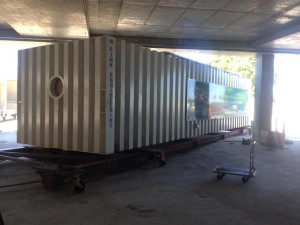
Triple Lock Hyperbaric Chamber being moved into position at the New royal Adelaide hospital. A trolley was built to accommodate the chamber and move it through the carpark area to its new home inside the hospital. The Hyperbaric unit is currently being built around the chamber and the New Hospital is scheduled for completion in 2016.
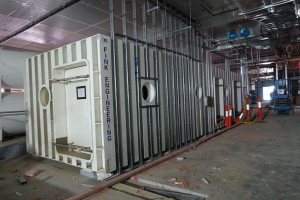
The triple lock Hyperbaric chamber in position at the New Royal Adelaide Hospital as construction work continues. This picture shows the process of cladding the chamber to allow it to blend into the hospital decor.
January 23, 2015
Fink Engineering recently delivered a first of its kind Mobile Equine Hyperbaric Oxygen Therapy system to MEHOT in California. The system is entirely self-contained, with the chamber and supporting plant assembled into a custom designed standard width trailer which can easily be transported to where it is needed.
As with our range of Rectangular hyperbaric Oxygen Therapy facilities for human occupancy the Equine patients inside the chamber breathe 100% pure oxygen while the chamber is pressurised with air. Oxygen is administered to the Equine patients via Fink Engineering’s custom designed Equine Hyperbaric oxygen mask which incorporates a humidification circuit to ensure the mucous membranes do not dry out.
With over 20 years of development and design of rectangular hyperbaric systems for clinical use, Fink Engineering maintain the same levels of safety for our Equine patients as we do for our human patients. The Mobile Equine Hyperbaric chamber is pressurised with air which is constantly flushed throughout the treatment providing ventilation and preventing the build up of oxygen inside the chamber. The chamber environment is constantly monitored to measure the percentage of oxygen inside the chamber and ensure to it does not rise above safe levels.
As with our chambers for human occupancy, the operation of the the Mobile Equine Hyperbaric system is computer controlled via touchscreen with manual override. Pre-defined and customisable treatment profiles make for simple operation of the chamber. This system includes the first implementation of our new Gen 4 software which is the result of 20 years of experience in computer control for hyperbaric systems.
The equine facilities are equipped with a fire deluge system modelled on the system we use in our human chambers, and just as our human patients wear special clothing for treatment, our equine patients are equipped with protective boots. As an extra precaution the walls and floor are covered with a tough sprayed on protective coating which will not peel or de-laminate even under extreme abuse.
For more informnation on Mobile Equine Hyperbaric centres please contact www.mehotcenters.com
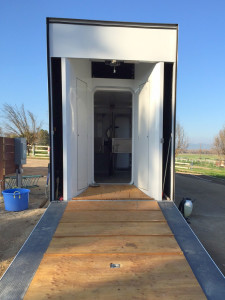
Looking into the Mobile Equine Hyperbaric Therapy (MEHOT) chamber, the central door makes it easy to load two horses side by side and the tapered corridor helps to guide the horses into the chamber.
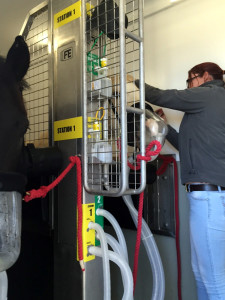
Horses fitted with Oxygen Masks inside the Mobile Equine Hyperbaric Therapy (MEHOT) chamber. The specially designed Equine oxygen system ensures that the Equine athletes receive 100% pure oxygen throughout the course of their treatment. The Oxygen supply is humidifed to prevent the drying out of mucous membranes.
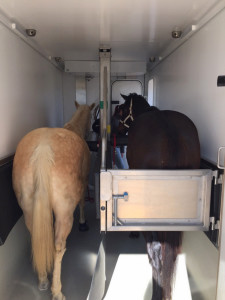
View from the main door showing 2 horses loaded inside the Mobile Equine Hyperbaric Therapy (MEHOT) chamber, the attendant can be seen at the front of the horses.
December 12, 2014
Fink Engineering’s latest triple lock chamber has left our factory and is now on site at the New Royal Adelaide Hospital. The Chamber, Air Receivers and Deluge Tanks left Queensland on Monday 8th December and arrived in Adelaide three days later on Thursday 11th.
Due to the size of the unit, the chamber has to be loaded in while the hospital is under construction and then the hyperbaric area will be built around it. Fink Engineering will be on site in 2015 to finish the fit-out and commissioning.
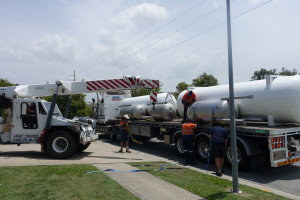
Air Receivers and Deluge tanks for the New Royal Adelaide Hospital Hyperbaric facility being loaded for transport
December 1, 2014
It’s been a busy end to 2014 for Fink Engineering. Shortly before we shipped the New Royal Adelaide triple lock we shipped one of our SLEQ Equine hyperbaric chambers to Ireland.
This SLEQ is slightly different from the other SLEQ we have manufactured, taking advantage of our years of experience with other units in the field, subtle design tweaks make the day-to-day running easier for the operators. One of the biggest changes being the implementation of our Gen4 Hyperbaric Control System, custom developed in-house, the Gen4 Hyperbaric Control System represents a significant leap forward to what is already class leading Hyperbaric Control software.
The SLEQ is currently on a vessel bound Ireland and Fink Engineering will be on site to finalise installation and operator training prior in the early part of 2015.
October 22, 2014
Fink Engineering recently delivered another SNDL Medical lock (Medlock) closure for the US Navy’s Standard Nato Double Lock diving Hyperbaric Chamber (SNDL). The SNDL and Medlock closure were both designed by Fink Engineering.
October 22, 2014
Fink Engineering installed their first Rectangular hyperbaric chamber at the Royal Adelaide Hospital in 1994, now in Fink Engineering’s 20th Anniversary year, history repeats itself with a new triple lock chamber for the New Royal Adelaide Hospital
The pressure vessel has been fabricated and hydrostatically tested at W.E. Smith Engineering in Coffs Harbour NSW, and is now painted and in our shop for outfitting and functional testing.
The Chamber and with supporting plant will be installed in the new hospital before Christmas with completion and testing to take place early next year.
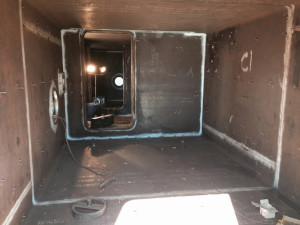
The New Royal Adelaide Hyperbaric Chamber during construction phase. Chamber is orientated upside down to facilitate welding of attachment points on the roof
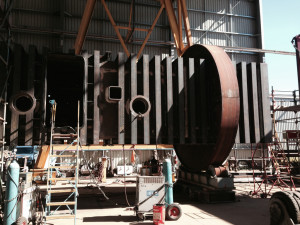
New Royal Adelaide Hyperbaric Chamber during Construction, temporary rollers are welded to the chamber to allow it to be turned during construction.
June 1, 2012
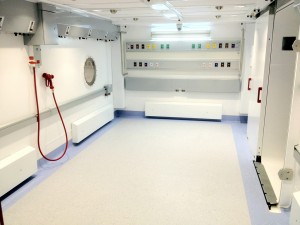
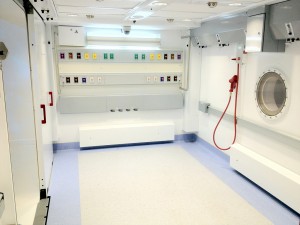
Fink Engineering completed the installation and commissioning of the Hennepin County Hospital’s new Triple Lock Hyperbaric Facility in May of this year and Dr Cheryl Adkinson and her team will commence patient treatments later this week after having spent the last few weeks training with the new system. Hyperbaric operations will then move from their existing chamber site which has been in operation since the mid 60’s to their new facility that has been completed on time and within budget under the direction of Mr. Tom Bravo, Director of Facilities Services.
Fink commenced on-site installation of the Life Support Systems for the chamber in January this year after the hospital renovation works were completed for the hyperbaric area. The Fire Deluge tanks, LP compressors and gas storage were installed above the chamber in the third floor mechanical room specially designed for the purpose.
The control console was built at Fink’s works in Australia and re-assembled on site and interconnected to the chamber via pre-run cabling.
FE’s new and improved operating software maintains the very user-friendly operator interface required for combining intensive care patients use with routine wound care patients in two different locks whilst still leaving an Entrance Lock free for access.
Of particular interest for this chamber is the unique headwall installation; a concept promoted by Bill Gossett that facilitates the same Med Gas and Medical Monitoring configuration found in the balance of the hospital. Compartments 1 & 3 have dual Headwall Installations whilst Compartment 2 has a single to allow enough room for the customised toilet surround.
Provision has been made to enable Treatment Locks 2 and 3 to have a future hypobaric capability thus enabling research in simulated altitude conditions. Each lock is fitted with FE’s unique whisper quiet pressurisation/depressurisation and environmental control system that keeps the internal noise level in the low 50’s dBA level. Each lock is also boasts FE’s unique square medical lock and full size rectangular doors which roll on stainless steel frictionless bearings.
This unique chamber has also been designed and partially outfitted for the future installation of the equipment necessary to turn Treatment Locks 2 and 3 into altitude locks
June 1, 2012
Construction is well underway for Fink Engineering’s new Rectangular Triple Lock Hyperbaric Chamber to be delivered to the new Fiona Stanley Hospital in Western Australia later this year. The new chamber will form part of FE’s hyperbaric installation, which consists of a low pressure air system. medical gas distribution, life support services including fire deluge, environmental control, gas analysis, communications, internal surveillance, entertainment and our computer controlled operating system.
Completion of the facility will continue early next year with the hospital scheduled to open thereafter.
June 1, 2012
The NSW Minister for Health Jillian Skinner officially opened the world’s largest rectangular hyperbaric facility designed and built by Fink Engineering in February of this year after having been operational for the previous ten months. The new facility replaced the existing cylindrical chamber that had been operational for the past 40+ years.
The new innovative chamber has four compartments and is capable of seating 30 patients. One of the large compartments is used for the routine treatment of intensive care patients and the other large compartment for routine wound care. The smaller entrance compartment provides access to each of the above and the smallest end compartment is used for treatment of decompression illness and for training.
FE commissioned the supporting plant and equipment to power the chamber including the compressors, filters, piping, deluge and sanitary systems last year. The chamber operates from a central control panel which utilises Fink’s innovative intuitive software to pressurise and depressurise each of the compartments via touch screen and Fink’s proven user-friendly software. Wireless communications, audio/visual entertainment, quiet and effective environmental control, modern toilet facilities and other user friendly support systems developed by FE over the past decade were incorporated to make it efficient and comfortable for both patients, nurses, physicians and operators.